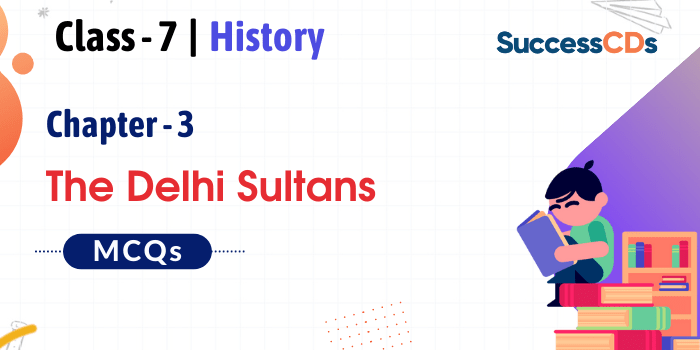NCERT Class 7 History Chapter 3 “The Delhi Sultans” Multiple Choice Question with Answers
The Delhi Sultans MCQs – Here is a compilation of Free MCQs of Class 7 History Book Chapter 3 The Delhi Sultans. Students can practice free MCQs as have been added by CBSE in the new exam pattern. At the end of Multiple Choice Questions, the answer key has also been provided for your reference
Q1. Which of the following was NOT the king of the Rajput Dynasty?
A. Tomaras
B. Ananga Pala
C. Prithviraj Chauhan
D. Bahlul Lodi
Q2. Which ruler first established his capital at Delhi?
A. Chauhans ruler
B. Tomara Rajput ruler
C. Turkish ruler
D. Khilji dynasty
Q3. Who was the first slave king of Delhi Sultanate?
A. Qutbuddin Aibak
B. Iltutmish
C. Raziyya Sultan
D. Alauddin Khalji
Q4. Who was successor of Muhammad-bin Tughluq?
A. Ghiyasuddin Tughluq
B. Firuz Shah Tughluq
C. Ibn Battuta
D. None of these
Q5. What was the language of administration under the Delhi Sultans?
A. Urdu
B. Persian
C. Hindi
D. English
Q6. The position of standing facing Mecca during namaz is known as
A. Khutba
B. Qibla
C. Sijdah
D. Kharaj
Q7. In whose reign did the Sultanate reach its farthest extent?
A. Tomara Rajput
B. Raziyya
C. Alauddin Khalji
D. Muhammad-bin Tughluq
Q8. Who was Ulema?
A. A slave purchased for military service
B. A ruler
C. A scholar of Islamic learning
D. An invader
Q9. A fortified settlement with soldiers was
A. hinterland
B. garrison town
C. Jagir
D. none of these
Q10. Which was NOT the kind of taxes during Delhi Sultanate?
A. Kharaj
B. Tax on cattles
C. Tax on houses
D. Bandagans
Q11. Kharaj was a type of tax on
A. houses
B. Cattle
C. trade
D. cultivation
Q12. Which Mughal emperor followed Sher Shah Suri’s idea of administration?
A. Humayun
B. Akbar
C. Babur
D. Aurangzeb
Q13. …………. dynasty ruled Delhi before the Tughluqs.
A. Chauhans
B. Tomara
C. Turkish
D. Khilji
Q14. Tarikh or Tawarikh were written in ………….
A. Urdu
B. English
C. Persian
D. Hindi
Q15. ……….. was built by two rulers Qutbuddin Aybak and Iltutmish.
A. Red fort
B. Taj Mahal
C. Qutb Minar
D. Fort of Hyderabad
Q16. …………. is a sermon during Friday prayer in the Mosque.
A. Khutba
B. Qibla
C. Sijdah
D. Kharaj
Q17. Leader of the Namaz is ……………
A. Imam
B. Maulvi
C. Maulana
D. Priest
Q18. Raziyya Sultan ruled from ………… to 1240 AD.
A. 1235
B. 1236
C. 1232
D. 1231
Q19. Delhi became an important city under the rule of
A. Chauhans
B. Tomaras
C. Turks
D. A & B
Q20. Delhi’s authority was challenged by ………. invasions
A. Mongols
B. Mughals
C. Turks
D. None
Q21. Rudramadevi ruled the Kakatiya Dynasty from…….?
A. 1262 – 1289
B. 1130 – 1145
C. 1165 – 1192
D. 1414-1451
Q22. The Delhi Sultans were dependent upon….?
A. Trade, tribute or plunder for supplies
B. Taxes from tourists
C. Taxes from artisans
D. None
Q23. Name the first mosque built by Delhi Sultans?
A. Jama Masjid
B. Moth Ki Masjid
C. Quwwat Al Islam
D. Jamali Kamali Masjid
Q24. Who built Quwwat Al Islam?
A. Iltutmish
B. Ghiyasudhin Balban
C. Raziya Sultan
D. Allaudin Khilji
Q25. Which mosque is Sanctuary of the World?
A. Begumpuri Mosque
B. Moth Mosque
C. Neeli Mosque
D. Jamali Kamali Masjid
Q26. Ziyauddin Barani was…..?
A. An archeologist
B. A warrior
C. Sultan
D. A muslim political thinker of Delhi Sultanate
Q27. Ibn Batuta belonged to…..?
A. Iran
B. Morocco
C. Afghanistan
D. China
Q28. Shershah Suri started his career as a ……?
A. Accountant
B. Soldier
C. Manager
D. Traveller
Q29. Balban was a Sultan of which dynasty?
A. Tughluq
B. Khilji
C. Sayyad
D. Turkish
Q30. What was the duty of the Muqtis?
A. To lead rulers
B. To lead military campaigns
C. To lead the country
D. None
Answer key for Class 7 History Book Chapter 3 “The Delhi Sultans” MCQs
| Question No. | Answer | Question No. | Answer |
| 1 | D | 16 | A |
| 2 | B | 17 | A |
| 3 | A | 18 | B |
| 4 | B | 19 | D |
| 5 | B | 20 | A |
| 6 | B | 21 | A |
| 7 | D | 22 | A |
| 8 | C | 23 | C |
| 9 | B | 24 | A |
| 10 | D | 25 | A |
| 11 | D | 26 | D |
| 12 | B | 27 | B |
| 13 | D | 28 | C |
| 14 | C | 29 | A |
| 15 | C | 30 | B |
